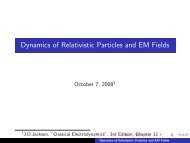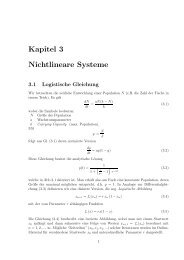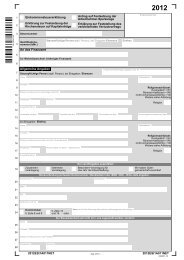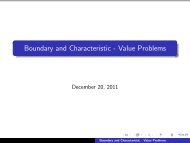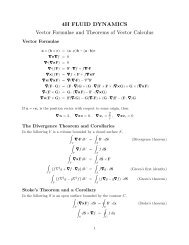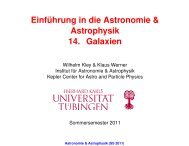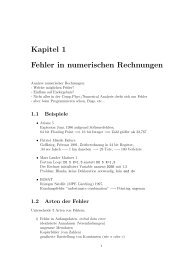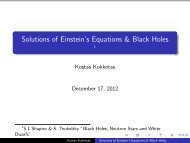Field Theory exam II â Solutions
Field Theory exam II â Solutions
Field Theory exam II â Solutions
Create successful ePaper yourself
Turn your PDF publications into a flip-book with our unique Google optimized e-Paper software.
<strong>Field</strong> <strong>Theory</strong> <strong>exam</strong> <strong>II</strong> – <strong>Solutions</strong><br />
Problem 1<br />
(a) Consider 2 point charges, one with charge q located at ⃗x 1 = (1, 0, 1), and<br />
the other one with charge −q at ⃗x 2 = (1, 0, −1). Compute the multipole<br />
moments q lm in terms of the associated Legendre polynomials P lm . Show<br />
that q lm = 0 if l + m is even.<br />
(b) Let q lm be the multipole moments of an arbitrary charge distribution, and<br />
¯q lm the ones for the same distribution rotated by an angle β around the<br />
z-axis. Express ¯q lm in terms of q lm and β.<br />
(c) Now consider a charge distribution consisting of n times the configuration<br />
from (a), but each rotated around the z-axis by an angle β k = 2πk/n,<br />
where k = 0 . . . n − 1. Compute the multipole moments q lm by either<br />
combining the previous results or by explicit calculation. Compute the<br />
dipole moment ⃗p as well.<br />
(d) Show that q lm = 0 if m/n is not an integer number.<br />
Required knowledge<br />
• Definition of the multipole moments<br />
∫<br />
q lm = Ylm(θ, ∗ φ)r l ρ(r, θ, φ)d 3 x (1)<br />
• The spherical harmonic functions<br />
Y lm (θ, φ) = N lm P lm (cos(θ))e imφ ,<br />
N lm ≡<br />
√<br />
2l + 1 (l − m)!<br />
4π (l + m)!<br />
(2)<br />
• The relations between multipole moments q lm and dipole moment ⃗p<br />
• The identities<br />
Solution<br />
q ∗ 11 = −N 11 (p x − ip y ) q ∗ 10 = N 10 p z (3)<br />
P lm (−x) = (−1) l+m P lm (x) (4)<br />
n−1<br />
∑<br />
r k = 1 − rn<br />
1 − r<br />
k=0<br />
(a) The given charge distribution can be written as<br />
if r ≠ 1 (5)<br />
ρ(⃗x) = qδ(⃗x − ⃗x 1 ) − qδ(⃗x − ⃗x 2 ) (6)<br />
The charge positions in spherical coordinates read<br />
r 1 = r 2 = r = √ 2 φ 1 = φ 2 = 0 θ 1 = 1 4 π θ 2 = 3 4 π (7)<br />
1
From (1) we obtain<br />
∫<br />
q lm =<br />
∫<br />
=<br />
With (2) and e −0i = 1 we get<br />
Y ∗<br />
lm(θ, φ)r l ρ(r, θ, φ)d 3 x (8)<br />
Y ∗<br />
lm(θ, φ)r l q (δ(⃗x − ⃗x 1 ) − δ(⃗x − ⃗x 2 )) d 3 x (9)<br />
= qYlm(θ ∗<br />
1 , φ 1 )r1 l − qYlm(θ ∗<br />
2 , φ 2 )r2 l (10)<br />
= qr l (Ylm(θ ∗<br />
1 , 0) − Ylm(θ ∗<br />
2 , 0)) (11)<br />
q lm = qr l N lm (P lm (cos(θ 1 )) − P lm (cos(θ 2 ))) (12)<br />
We have<br />
( ) 1<br />
cos(θ 1 ) = cos<br />
4 π = √ 1<br />
(13)<br />
2<br />
Using (4) we finally arrive at<br />
cos(θ 2 ) = cos(π − θ 1 ) = − cos(θ 1 ) (14)<br />
q lm = qr l N lm P lm (cos(θ 1 )) ( 1 − (−1) l+m) (15)<br />
Obviously, q lm = 0 if l + m is an even number. Otherwise,<br />
q lm = 2qr l N lm P lm (cos(θ 1 )) (16)<br />
(b) From (2) we get the transformation of the spherical harmonic functions<br />
under rotation<br />
Y lm (θ, φ) = N lm P lm (cos(θ))e imφ (17)<br />
= N lm P lm (cos(θ))e im(φ−β) e imβ (18)<br />
= Y lm (θ, φ − β)e imβ (19)<br />
⇒ Y ∗<br />
lm(θ, φ) = Y ∗<br />
lm(θ, φ − β)e −imβ (20)<br />
If ρ is an arbitrary charge distribution and ¯ρ the same distribution rotated<br />
by an angle β around the z-axis, we have ¯ρ(r, θ, φ) = ρ(r, θ, φ − β). For<br />
the multipole moments, we compute from (1)<br />
∫<br />
¯q lm = Ylm(θ, ∗ φ)r l ¯ρ(r, θ, φ)d 3 x (21)<br />
∫<br />
= Ylm(θ, ∗ φ − β)e −imβ r l ρ(r, θ, φ − β)d 3 x (22)<br />
= e −imβ ∫<br />
= e −imβ ∫<br />
Y ∗<br />
lm(θ, φ − β)r l ρ(r, θ, φ − β)d 3 x (23)<br />
Y ∗<br />
lm(θ, φ)r l ρ(r, θ, φ)d 3 x (24)<br />
= e −imβ q lm (25)<br />
where (23) and (24) are equal because the integral runs over all angles φ.<br />
2
(c) If we rotate the charge configuration from (a) by the angle β k = 2πk/n<br />
around the z-axis, we can get the corresponding multipole moment using<br />
(25)<br />
q k lm = e −imβ k<br />
q lm = e −im2π k n qlm (26)<br />
where q lm is the multipole moment of the distribution from (a). As one can<br />
easily see from (1), the combined multipole moment ˜q lm of the n rotated<br />
configurations is just the sum of the single multipole moments, i.e.<br />
n−1<br />
∑<br />
n−1<br />
∑<br />
n−1<br />
∑<br />
˜q lm = qlm k = e −im2π k n qlm = q lm e −im2π k n (27)<br />
k=0<br />
k=0<br />
k=0<br />
n−1<br />
∑<br />
= q lm a k , a ≡ e −2iπ m n (28)<br />
k=0<br />
If m/n is not an integer, we have a ≠ 1 and, by using (5),<br />
1 − a n<br />
˜q lm = q lm<br />
1 − a = q 1 − e −2iπm<br />
lm<br />
= 0 (29)<br />
1 − a<br />
If m/n is an integer on the other hand, we have a = 1 and obtain<br />
n−1<br />
∑<br />
˜q lm = q lm 1 k = nq lm (30)<br />
k=0<br />
From part (a), we know that q 11 = 0, since l + m = 1 + 1 = 2 is even.<br />
Further, since 0/n is integer, ˜q 10 = nq 10 . Using this in (3), we get the<br />
dipole moment<br />
˜p x = ˜p y = 0 (31)<br />
˜p z = N10 −1 10 = N10 −1 10 = nN10 −1 N 10 P 10 (cos(θ 1 )) (32)<br />
= 2nqrP 10 (cos(θ 1 )) = 2nqr cos(θ 1 ) = 2nqz 1 (33)<br />
= 2nq (34)<br />
(d) This was already shown in (c), see (29).<br />
Problem 2<br />
Imagine two conducting hollow spheres around the origin, with radius R 0 and<br />
R 1 (where R 1 − R 0 > 0), and a thickness negligible in comparison to the radius.<br />
Assume that the spheres have a conductivity σ > 0, and that the system is in<br />
a stationary state without any currents.<br />
(a) Use Ohm’s law to show that the electrostatic potential Φ is constant on<br />
each of the spheres, that the electric field vanishes inside the conducting<br />
material, and that it is orthogonal to the surface outside the material.<br />
(b) Use Gauss’ law to show that the inner surface of the inner sphere is uncharged,<br />
and that the electric field inside the inner sphere is zero.<br />
3
(c) Assume that the inner surface of the outer sphere carries a total charge Q 1 .<br />
Compute the electric field ⃗ E(r) between the two spheres, the total charge<br />
Q 0 on the outer surface of the inner sphere, and the charge densities on<br />
the surfaces.<br />
(d) Compute the voltage U between the two spheres in terms of Q 1 , and the<br />
capacitance C = |Q 1 /U| of the capacitor formed by the concentric spheres.<br />
(e) From the electric field, compute the total energy W of the electric field<br />
between the two spheres in terms of U and C.<br />
Required knowledge<br />
• Ohm’s law: in a conductor with conductivity σ, electric field and current<br />
are related by ⃗ J = σ ⃗ E<br />
• Gauss law: given a vector field ⃗w and a volume V with surface ∂V ,<br />
∫ ∫<br />
⃗∇ · ⃗w = ⃗w · ⃗nda (35)<br />
• Coulomb’s law (in Gauss units)<br />
V<br />
∂V<br />
⃗∇ · ⃗E = 4πρ (36)<br />
• Definition of electrostatic potential ⃗ E = − ⃗ ∇Φ<br />
• Energy density of the electric field (in Gauss units)<br />
Solution<br />
u = 1<br />
8π ⃗ E 2 (37)<br />
(a) Because we assume ⃗ J = 0, it follows that ⃗ E = 0 inside the conducting material,<br />
otherwise there would be a current ⃗ J = σ ⃗ E due to Ohm’s law. From<br />
⃗E = − ⃗ ∇Φ, it follows that Φ is constant inside the conducting material.<br />
Since the tangential component of ⃗ E is continuous across surfaces (due to<br />
Faraday’s law), it is also zero near the surface outside the conductor, and<br />
therefore orthogonal to the surface.<br />
(b) First we note that since the system is spherically symmetric, all quantities<br />
can only depend on r. This implies that the electric field has only radial<br />
components E r (r), and that the surface charge densities are constant along<br />
each of the sphere’s surfaces. For any sphere V r with radius r and surface<br />
∂V r , we can combine Gauss and Coulomb’s laws to compute<br />
∫<br />
∫<br />
4πr 2 E r (r) = E ⃗ · ⃗n da = ∇ ⃗ · E ⃗ d<br />
∫∂V 3 x ′ = 4π ρ d 3 x ′ (38)<br />
r V r V r<br />
= 4πQ(r) (39)<br />
where Q(r) is the total charge inside a radius r. Inside the conducting<br />
material, we have ⃗ E = 0, and, due to (36), also ρ = 0. Thus the only<br />
4
charges sit on the surfaces of the hollow spheres. In the following, we<br />
denote the arbitrary small thickness of the hollow sphere shells by 2ɛ and<br />
assume that their outer and inner surfaces are located at r = R 0 ± ɛ and<br />
r = R 1 ± ɛ. We have already shown in (a) that E r (R 0 ) = 0. Evaluating<br />
(39) at r = R 0 , we thus find that Q(R 0 ) = 0. On the other hand, Q(R 0 )<br />
is nothing but the total charge on the inner surface of the inner hollow<br />
sphere. Since the corresponding surface charge density is constant, it has<br />
to vanish as well. Evaluating (39) at r < R 0 − ɛ, we find that E r (r) = 0,<br />
since the total charge Q(r) inside the radius r < R 0 − ɛ is zero. Since<br />
the nonradial components of the electric field are zero as well due to the<br />
spherical symmetry, we have E ⃗ = 0 inside the inner sphere.<br />
(c) Using (39) again, we find that<br />
Therefore,<br />
Q 0 + Q 1 = Q(R 1 ) = R 2 1E r (R 1 ) = 0 (40)<br />
Q 0 = −Q 1 σ 0 = − Q 1<br />
4πR 2 0<br />
σ 1 = Q 1<br />
4πR 2 1<br />
(41)<br />
Between the inner and outer spheres, i.e. for R 0 +ɛ < r < R 1 −ɛ, equation<br />
(39) yields<br />
E r (r) = 1 r 2 Q(r) = 1 r 2 Q 0 = − 1 r 2 Q 1 (42)<br />
(d) The voltage U between the spheres is the difference<br />
∫ R1<br />
U = Φ(R 1 ) − Φ(R 0 ) = −<br />
R 0<br />
E r (r)dr =<br />
[<br />
= Q 1 − 1 ] R1<br />
( 1<br />
= Q 1 − 1 )<br />
r<br />
R 0<br />
R 0 R 1<br />
The capacitance follows as<br />
(e) The total energy in the field is<br />
W =<br />
Problem 3<br />
∫ R1<br />
= Q2 1<br />
2<br />
∫ R1<br />
R 0<br />
1<br />
r 2 Q 1dr (43)<br />
(44)<br />
( C =<br />
Q 1<br />
1<br />
∣ U ∣ = − 1 ) −1<br />
(45)<br />
R 0 R 1<br />
∫ R1<br />
u(r)4πr 2 dr = 1 r 2 E ⃗ 2 (r)dr = Q2 1<br />
R 0<br />
2 R 0<br />
2<br />
[<br />
− 1 ] R1<br />
( 1<br />
− 1 )<br />
r<br />
R 0 R 1<br />
= Q2 1<br />
R 0<br />
2<br />
∫ R1<br />
1<br />
dr (46)<br />
R 0<br />
r2 = Q2 1<br />
2C = C 2 U 2 (47)<br />
A particle with charge q moves with constant relativistic velocity v = βc along<br />
the x-axis.<br />
5
(a) By applying a Lorentz-boost from the rest frame of the particle to the<br />
laboratory frame, prove that the electromagnetic fields are given by<br />
⃗E = γq (⃗x − t⃗v)<br />
r<br />
′3<br />
⃗B = γq ⃗v × ⃗x<br />
cr<br />
′3<br />
r ′2 = γ 2 (x 1 − vt) 2 + x 2 2 + x 2 3<br />
(b) Compute the corresponding Poynting vector ⃗ S in terms of ⃗v, ⃗x, t, and r ′ .<br />
Also compute | ⃗ S|.<br />
Required knowledge<br />
• If K and K ′ are two inertial coordinate frames, and K ′ moves with velocity<br />
βc in in x-direction with respect to system K, and the coordinate axes are<br />
not rotated against each other, then the relativistic transformation is the<br />
Lorentz-boost given by<br />
x ′ 0 = γ(x 0 − βx 1 )<br />
x ′ 1 = γ(x 1 − βx 0 ) (48)<br />
x ′ 2 = x 2 x ′ 3 = x 3<br />
• The electromagnetic fields transform under the above Lorentz-boost like<br />
E 1 = E 1 ′ B 1 = B 1<br />
′<br />
E 2 = γ (E 2 ′ + βB 3) ′ B 2 = γ (B 2 ′ − βE 3) ′ (49)<br />
E 3 = γ (E ′ 3 − βB ′ 2) B 3 = γ (B ′ 3 + βE ′ 2)<br />
• The electric field of a charge q at rest at the origin is given by<br />
⃗E =<br />
q ⃗x (50)<br />
|⃗x|<br />
3<br />
• The Poynting vector in vacuum (in Gauss units) is given by<br />
Solution<br />
⃗S = c<br />
4π ⃗ E × ⃗ B (51)<br />
(a) In the following, the quantities with a prime are defined with respect to the<br />
rest frame of the particle, unprimed ones with respect to the laboratory<br />
frame. Since the particle moves with constant velocity, it’s rest frame is<br />
an inertial frame. In the rest frame of the particle, there is no magnetic<br />
field and the electric field is given by<br />
⃗E ′ = q<br />
r ′3 ⃗x′ r ′ ≡ |⃗x ′ | (52)<br />
6
Using the transformation rule (49) and the Lorentz-boost (48), we get the<br />
electric field in the laboratory frame<br />
⎛ ⎞ ⎛ ⎞ ⎛<br />
⎞<br />
E 1<br />
′<br />
⃗E = ⎝γE 2<br />
′ ⎠ = q x ′ 1<br />
⎝γx ′ ⎠<br />
r ′3 2 = q γ (x 1 − βx 0 )<br />
⎝ γx<br />
r ′3 2<br />
⎠ (53)<br />
γx 3<br />
γE ′ 3<br />
= qγ<br />
r ′3 (<br />
⃗x − x 0<br />
⃗ β<br />
)<br />
γx ′ 3<br />
= qγ (⃗x − t⃗v) (54)<br />
r<br />
′3<br />
For the magnetic field, we get<br />
⎛ ⎞<br />
0<br />
⃗B = ⎝−βγE 3<br />
′ ⎠ = β ⃗ × E ⃗ = qγ<br />
βγE 2<br />
′ r ⃗ )<br />
′3 β ×<br />
(⃗x − x 0β ⃗ (55)<br />
= qγ<br />
r ⃗ ′3 β × ⃗x = qγ ⃗v × ⃗x<br />
cr<br />
′3<br />
(56)<br />
Using (48), we finally find<br />
r ′2 = x ′2<br />
1 + x ′2<br />
2 + x ′2<br />
3 = γ 2 (x 1 − vt) 2 + x 2 2 + x 2 3 (57)<br />
(b) Using (51), (55), and (54) we obtain<br />
⃗S = c E<br />
4π ⃗ × B ⃗ = 1<br />
= 1<br />
4π<br />
E<br />
4π ⃗ (<br />
×<br />
⃗v × E ⃗ )<br />
= 1 ( ( ) )<br />
⃗E 2 ⃗v − ⃗E · ⃗v ⃗E<br />
4π<br />
(58)<br />
( qγ<br />
r ′3 ) 2 (⃗y 2 ⃗v − (⃗y · ⃗v) ⃗y ) (59)<br />
where ⃗y ≡ ⃗x − t⃗v. Further,<br />
Problem 4<br />
| S| ⃗ = 1 ( qγ<br />
4π<br />
= 1<br />
4π<br />
) 2<br />
√<br />
r ′3 ⃗y 4 ⃗v 2 − 2⃗y 2 (⃗y · ⃗v) 2 + ⃗y 2 (⃗y · ⃗v) 2 (60)<br />
( qγ<br />
) 2<br />
√<br />
|⃗y|<br />
r ′3 ⃗y 2 ⃗v 2 − (⃗y · ⃗v) 2 (61)<br />
A particle with charge q, mass m, and velocity ⃗v crosses a region with a homogeneous<br />
magnetic field ⃗ B. Assume that the field is weak such that the particle<br />
moves approximately on a straight line with constant velocity.<br />
(a) Show that the instantaneous power radiated by the particle in terms of<br />
the force F ⃗ acting on the particle is given by<br />
P = 2q2 γ 2 ( ( ) ) 2<br />
⃗F 2<br />
3m 2 c 3 − ⃗F · β ⃗<br />
(b) From this, compute the instantaneous power radiated by the particle while<br />
inside the field region.<br />
(c) Compute the total energy W radiated by the particle in terms of the proper<br />
time τ F the particle spent inside the field region.<br />
7
Required knowledge<br />
• The instantaneously radiated power of an accelerated charge q is<br />
P = − 2 q 2 ( ) ( )<br />
dpµ dp<br />
µ<br />
3 m 2 c 3 dτ dτ<br />
(62)<br />
where p µ<br />
particle.<br />
= (p 0 , ⃗p) is the 4-momentum and τ the proper time of the<br />
• Proper time in terms of laboratory time<br />
dt<br />
dτ = γ ≡ ( 1 − β 2) − 1 2<br />
(63)<br />
• The relation between force and change of 4-momentum<br />
d<br />
dt ⃗p = ⃗ F<br />
d<br />
dt p 0 = ⃗ β · ⃗F (64)<br />
• The Lorentz force acting on a charge inside a magnetic field<br />
⃗F = q ⃗ β × ⃗ B (65)<br />
Solution<br />
(a) From (62), we get<br />
P = − 2 q 2 ( ) ( )<br />
dpµ dp<br />
µ<br />
3 m 2 c 3 = − 2 q 2 γ 2 ( ) ( )<br />
dpµ dp<br />
µ<br />
dτ dτ 3 m 2 c 3 dt dt<br />
( (d⃗p<br />
= 2 q 2 γ 2 ) 2 ( ) dp<br />
0 2<br />
)<br />
3 m 2 c 3 −<br />
dt dt<br />
With (64), this becomes<br />
P = 2 q 2 γ 2 ( ( ) ) 2<br />
⃗F 2<br />
3 m 2 c 3 − ⃗β · F ⃗<br />
(66)<br />
(67)<br />
(68)<br />
(b) Inside the magnetic field region, the force acting on the particle is the<br />
Lorentz force (65). We compute<br />
⃗F · ⃗β<br />
( )<br />
= q ⃗β × B ⃗ · ⃗β = 0 (69)<br />
⃗F 2 = q 2 ( ⃗ β × ⃗ B<br />
) 2<br />
= q<br />
2⃗ β<br />
2 ⃗ B 2 sin 2 (α) (70)<br />
where α is the angle between β ⃗ and B. ⃗ Inserting in (68) yields the result<br />
P = 2 q 4 γ 2<br />
3 m 2 c ⃗ 3 β 2 B ⃗ 2 sin 2 (α) (71)<br />
8
(c) Assuming that the particle moves with approximately constant velocity<br />
in a homogeneous magnetic field, the radiated power P and the Lorentz<br />
factor γ are also constant. Thus we only have to compute the laboratory<br />
time t F spent in the magnetic field from the corresponding proper time<br />
τ F . Since γ is constant, (63) gives us t F = γτ F . The total radiated energy<br />
is thus<br />
2 q 4 γ 3<br />
W = t F P = γτ F P = τ F<br />
3 m 2 c ⃗ 3 β 2 B ⃗ 2 sin 2 (α) (72)<br />
9




